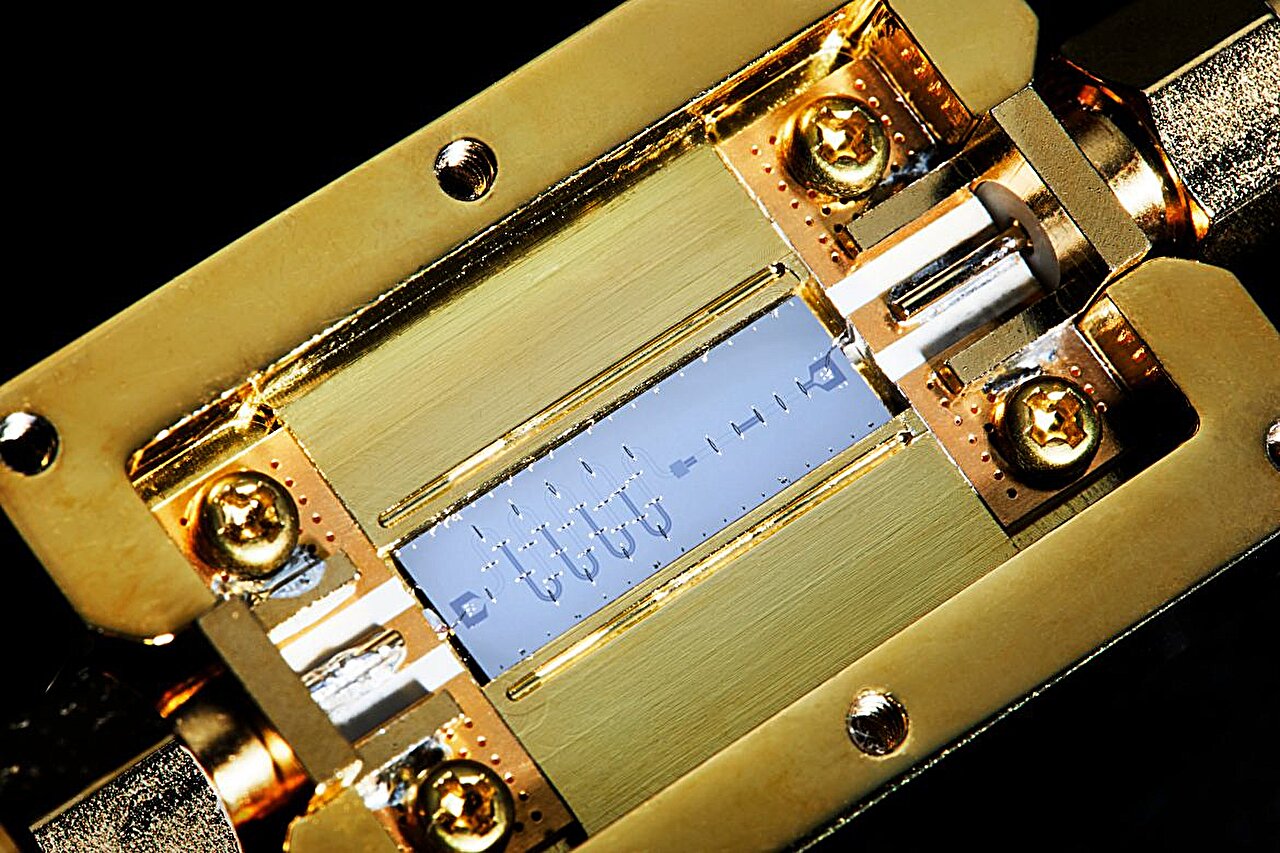× close
UNSW quantum engineers have developed a new amplifier that could help other scientists search for elusive dark matter particles.
Imagine throwing a ball. You’d expect science to be able to work out its exact speed and location at any given moment, right? Well, the theory of quantum mechanics says you can’t actually know both with infinite precision at the same time.
It turns out that as you more precisely measure where the ball is, knowing its speed becomes less and less accurate.
This conundrum is commonly referred to as Heisenberg’s uncertainty principle, named after the famous physicist Werner Heisenberg who first described it.
For the ball, this effect is imperceptible, but in the quantum world of small electrons and photons the measurement uncertainty suddenly becomes very significant.
That’s the problem being addressed by a team of engineers at UNSW Sydney who have developed an amplifying device that performs precise measurements of very weak microwave signals, and it does so through a process known as squeezing.
Microwave squeezing
Squeezing involves reducing the certainty of one property of a signal in order to obtain ultra-precise measurements of another property.
The team of researchers at UNSW, led by Associate Professor Jarryd Pla, have significantly increased the accuracy of measuring signals at microwave frequencies, like those emitted by your mobile phone, to the point of setting a new world record.
The precision of measuring any signal is fundamentally limited by noise. Noise is the fuzziness that creeps in and masks signals, which is something you may have experienced if you’ve ever ventured out of range when listening to AM or FM radio.
However, uncertainty in the quantum world means there is a limit as to how low noise can be made in a measurement.
“Even in a vacuum, a space void of everything, the uncertainty principle tells us we must still have noise. We call this ‘vacuum’ noise. For many quantum experiments, vacuum noise is the dominant effect that prevents us from making more precise measurements,” says A/Prof. Pla from UNSW’s School of Electrical Engineering and Telecommunications, and co-author of a paper published in Nature Communications.
The squeezer produced by the UNSW team can beat this quantum limit.
“The device amplifies noise in one direction, so that noise in another direction is significantly reduced, or ‘squeezed.’ Think of the noise as a tennis ball, if we stretch it vertically, then it must reduce along the horizontal to maintain its volume. We can then use the reduced part of the noise to do more precise measurements,” A/Prof. Pla says.
“Crucially, we showed that the squeezer is able to reduce noise to record low levels.”
The device was the result of painstaking work. Ph.D. candidate Arjen Vaartjes, joint lead author on the paper together with UNSW colleagues Dr. Anders Kringhøj and Dr. Wyatt Vine, adds, “Squeezing is very difficult at microwave frequencies because the materials used tend to destroy the fragile squeezed noise quite easily.
“What we’ve done is a lot of engineering in order to remove sources of loss, which means utilizing very high-quality superconducting materials to build the amplifier.”
And the team believe that the new device could help speed up the search for notoriously elusive particles known as axions, which are so far only theoretical, but proposed by many as the secret ingredient of mysterious dark matter.
Axion measurements
Making precise measurements is the domain of scientists trying to discover what constitutes dark matter, which is believed to make up around 27 percent of the known universe, but remains a cosmic mystery since scientists have not been able to actually identify it.
As its name might suggest, it neither emits nor absorbs light which is what makes it “invisible.” But physicists believe it must be there, exerting a gravitational pull, otherwise galaxies would be flying apart.
There are many varied theories of what dark matter might be made of—including the proposed existence of so-called axions.
Axions themselves have also never been discovered, the theory being that they are almost unfathomably small, with an extremely low mass as an individual particle, and therefore interact virtually imperceptibly with other known matter.
However, one idea predicts that when exposed to large magnetic fields axions should produce very faint microwave signals. Scientists are using highly sensitive equipment and performing meticulous measurements in an attempt to spot those minute signals.
But as A/Prof. Pla says, “When trying to detect particles as ghostly as axions, even vacuum noise can be deafening.”
The work done on squeezing at UNSW means those measurements could now be done up to six times faster, improving the chances of discovering an elusive axion.
“Axion detectors can use squeezers to reduce noise and speed up their measurements. Our results indicate that those experiments could now be performed even faster than before,” says A/Prof. Pla.
“Scientists can see dark matter’s effects on galaxies, but no-one has ever detected it. Until you physically measure an axion, then it will only ever be a theory about how dark matter manifests.”
Broad use
Joint lead author Dr. Vine says there are other applications for the team’s new amplifying device.
“What we also showed in our study is that the device can be operated at higher temperatures than previous squeezers and also in large magnetic fields,” Dr. Vine says.
“This opens the door to applying it in techniques like spectroscopy, which is used to study the structure of new materials and biological systems such as proteins. The squeezed noise means you could study smaller volumes or measure samples with greater precision.”
Dr. Kringhøj notes that the squeezed noise itself could even be used in future quantum computers.
“It turns out that squeezed vacuum noise is an ingredient to build a certain type of quantum computer. Excitingly, the level of squeezing we’ve achieved is not far off the amount needed to build such a system,” he says.
More information:
Arjen Vaartjes et al, Strong microwave squeezing above 1 Tesla and 1 Kelvin, Nature Communications (2024). DOI: 10.1038/s41467-024-48519-3

Dr. Thomas Hughes is a UK-based scientist and science communicator who makes complex topics accessible to readers. His articles explore breakthroughs in various scientific disciplines, from space exploration to cutting-edge research.








